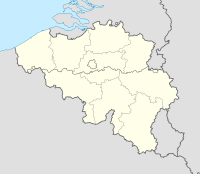Battle of Dinant (1914)
| Battle of Dinant | |||||||
|---|---|---|---|---|---|---|---|
| Part of the Battle of Charleroi during the Battle of the Frontiers in World War I | |||||||
 The town of Dinant before (below) and after (above) the battle and massacres. |
|||||||
|
|||||||
| Belligerents | |||||||
|
|
|
||||||
| Commanders and leaders | |||||||
|
|
|
||||||
| Units involved | |||||||
| Fifth Army | 3rd Army | ||||||
| Casualties and losses | |||||||
| 1,100–1,200 killed and wounded | 4,275 killed and wounded | ||||||
| 674~ Belgian civilians massacred | |||||||
|
|
|||||||
The Battle of Dinant was an engagement fought by French and German forces in and around the Belgian town of Dinant during the First World War during the German invasion of Belgium. The French Fifth Army and the British Expeditionary Force (BEF) advanced into Belgium and fought the Battle of Charleroi (21–23 August) and Battle of Mons (23 August), from the Meuse crossings in the east, to Mons in the west. On 15 August 1914, German troops captured the Citadel of Dinant overlooking the town until it was recaptured by a French counter-attack during the afternoon. French troops spent the next few days fortifying the Meuse crossings and exchanging fire with German troops on the east bank.
A German raiding-party drove into Dinant on the night of 21/22 August but the attack degenerated into a fiasco, in which Germans may have fired at each other. Rather than assume that the small-arms fire had come from the French on the west bank, the Germans blamed Belgian civilians, killing seven and burning down 15–20 houses in reprisal. The raiders ran away, with 19 dead and 117 wounded. On 23 August, the Germans attacked Dinant again, under the impression that the town was full of francs-tireurs and massacred 674 unarmed Belgian civilians, while fighting the French dug in along the west bank and on the east end of the bridge. The massacre was a systematic attack on assumed civilian resisters and was the largest German atrocity perpetrated during the invasion, which became known as The Rape of Belgium.
In 1914, the town had a population of 7,000 people and was an important strategic crossing on the Meuse, where the river flows through a south–north gorge. Three roads and a path converged on the town from the east, over an escarpment and down into the town, along which an attack from the east would come. The wooded ridge on the east bank was topped by the Napoleonic era stone Citadel of Dinant overlooking the town and the Meuse bridge, 100 m (330 ft) below. In 1914 there was a ribbon of streets about 4 km (2.5 mi) long on the east bank, a few hundred metres wide. Before the battle, the Mayor of Dinant urged the population to not take part in the fighting and forbade manifestations in support of the Allies.
...
Wikipedia

